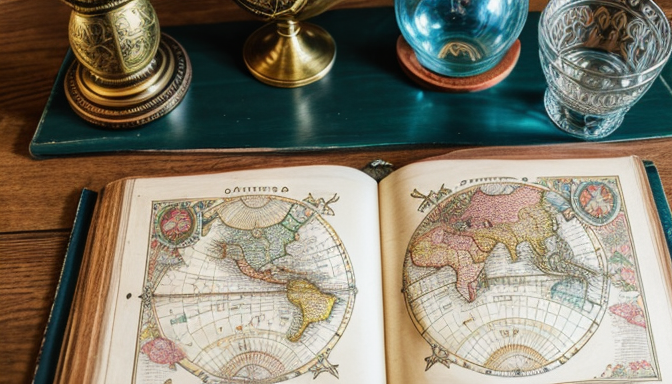Welcome to the fascinating world of cartography, where the boundaries of imagination and reality blur into vibrant landscapes! Cartography isn’t just about drawing lines on paper; it’s an art form that allows us to explore imaginary lands filled with adventure and mystery. Think about it: every great story has a map that guides the reader through enchanted forests, treacherous mountains, and sprawling kingdoms. These maps are more than mere illustrations; they are gateways to immersive worlds.
As we dive deeper into the evolution of maps, it’s remarkable to see how cartography has transformed from ancient scrolls to digital masterpieces. Imagine ancient explorers sketching their routes by hand, pouring their hearts into every curve and contour. Fast forward to today, and we have sophisticated software that allows creators to design intricate landscapes with the click of a button. This leap in technology has opened up new avenues for worldbuilding, allowing writers and artists to construct realms that feel as real as our own.
In literature, fictional maps serve as an essential tool for storytelling, guiding readers through the vast expanse of a writer’s imagination. These maps not only enhance the narrative but also deepen the reader’s connection to the story. For instance, consider how the detailed maps in J.R.R. Tolkien’s Middle-earth invite readers to traverse the lands of hobbits and elves, making the journey all the more thrilling. The interplay between landforms, realms, and kingdom borders in these maps enriches the experience, making it unforgettable.
The Evolution of Maps
Maps have undergone a remarkable transformation throughout history, evolving from simple sketches on animal hides to intricate digital representations that can be accessed at the touch of a button. In ancient times, cartographers relied on their imagination and observations of the natural world to create maps that were often more art than science. These early maps depicted not only the physical landscapes but also the myths and legends of the cultures that created them. As civilizations advanced, so did the complexity and accuracy of maps.
With the advent of the printing press in the 15th century, maps became more widely distributed, enabling explorers and traders to navigate the world more effectively. This period marked a significant shift in cartography, as maps began to reflect not just geographical features but also political boundaries and trade routes. The introduction of tools like the compass and sextant further enhanced navigational precision, paving the way for the Age of Exploration.
In the modern era, the rise of digital technology has revolutionized how we create and interact with maps. Geographic Information Systems (GIS) allow for the layering of information, enabling users to visualize everything from landforms and climate patterns to population density and urban development. This digital evolution has also influenced the realm of fantasy map-making, where authors and artists design imaginary lands with detailed realms and kingdom borders, enriching the storytelling experience.
Today, maps are not just tools for navigation; they are windows into our world, reflecting cultural identities and historical narratives. The evolution of maps illustrates a profound journey of human creativity and exploration, inviting us to continue imagining the worlds yet to be discovered.

Imaginary Lands in Literature
When we dive into the realm of literature, we often find ourselves transported to places that exist only in the minds of their creators. These imaginary lands are not just backdrops for stories; they are vibrant worlds filled with unique cultures, creatures, and landscapes that ignite our imagination. Think about it: how often have you flipped through the pages of a book, only to stumble upon a map that makes your heart race with excitement? These maps serve as the blueprints of fantasy, guiding readers through intricate realms where anything is possible.
Authors like J.R.R. Tolkien and C.S. Lewis have mastered the art of crafting immersive worlds. Tolkien’s Middle-earth, for example, is a tapestry woven with diverse landscapes, from the peaceful Shire to the treacherous peaks of Mordor. Each location is meticulously designed, with its own history, cultures, and even languages. This attention to detail allows readers to not just read about these places, but to feel as if they are walking through them, experiencing every twist and turn.
In many ways, these maps act as a visual guide to the story, helping to ground the fantastical elements in a relatable framework. When readers can see the borders of kingdoms, the paths taken by heroes, or the locations of epic battles, it enhances their understanding and engagement with the narrative. It’s like having a friend who knows the way through a maze—suddenly, the journey feels more tangible and real.
So, the next time you crack open a fantasy novel, take a moment to appreciate the artistry of the map. It’s not just a piece of paper; it’s an invitation to explore the unknown, a chance to lose yourself in a world where imagination knows no bounds.
Frequently Asked Questions
- What is cartography?
Cartography is the art and science of map-making. It involves not just the technical aspects of creating maps but also the creative process of representing geographical information in a way that is both informative and aesthetically pleasing.
- How have maps evolved over time?
Maps have come a long way from ancient hand-drawn representations to today’s sophisticated digital formats. The evolution includes significant milestones like the introduction of projection techniques and the advent of Geographic Information Systems (GIS) that allow for interactive mapping.
- Why are imaginary lands important in literature?
Imaginary lands in literature serve as a canvas for authors to paint their stories. They provide readers with immersive experiences, allowing them to escape reality and explore new worlds, much like stepping into a vivid dream.
- Can anyone create a map?
Absolutely! While professional cartographers have specialized training, anyone with a passion for geography and creativity can create a map. Whether it’s a hand-drawn treasure map or a digital representation of a fictional world, the possibilities are endless!

Recent Comments